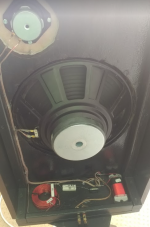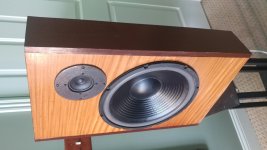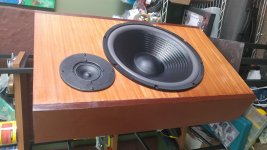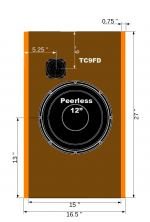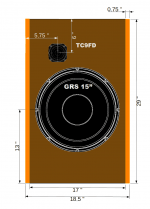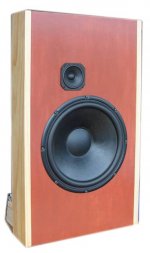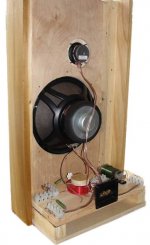Absolutely. I couldn't find my pair of pots so I included them in an order to buy a pair for front and back firing tweeters for my subsequent project and included a pair with the intent of using them for level matching in my next project with the tweeters (and then replacing with a resistor of the proper value) that I thought I might use to circle back and get more granular resistance values on these. I did manage to zero in to within an half ohm of where I want it and honestly, when I measure a lot of resistors they are off from 5-10% in tolerance to where a half ohm is really only a little bit more of a deviation than would be incurred just by crossover component variance. That said I likely still will do it it just has diminished importance in my project hierarchy. While I enjoy these and evaluate them the next few weeks I'll be assembling an h-frame 15" eminence alpha pair for use as a platform upon which to experiment with different mid or mid tweet combos.
The first application will be a pair of 12" Zenith 49cz1045 alnico units on h frames. Will feed the h frames with low frequencies via active crossover up to about 250hz . Above 250hz will be the Zenith running full range and then I will have a wired pair of supertweeters (horn loaded silk domes instead of compression/titanium/planar because I just prefer silk domes) that have a slightly higher efficiency than the Zenith. I will put a single 2uf cap inline on the tweeter to roll it off at 10k and will employ the lpads for level control on the tweeters.
The first application will be a pair of 12" Zenith 49cz1045 alnico units on h frames. Will feed the h frames with low frequencies via active crossover up to about 250hz . Above 250hz will be the Zenith running full range and then I will have a wired pair of supertweeters (horn loaded silk domes instead of compression/titanium/planar because I just prefer silk domes) that have a slightly higher efficiency than the Zenith. I will put a single 2uf cap inline on the tweeter to roll it off at 10k and will employ the lpads for level control on the tweeters.
Quick question, for the 12” Peerless Woofer version: is the baffle supposed to be 15” wide including the side 3/4” solid wood boards - making the total width 16.5”, or including the 3/4 in solid wood (making the plywood baffle width 13.5” - prior to attaching solid wood sides). Also, is the side solid wood 5” wide panels attached to the baffle on the rear side of the baffle, making effective overall speaker depth of 5.75”, or is it mounted on the side - keeping the speakers effective depth equivalent to the width of the side solid panels (i.e. 5”).
I've built it both ways. John builds his with the wings on the outside. See here starting post 1601:
Fast, fun, Inexpensive OB project
Fast, fun, Inexpensive OB project
Pano,
I have the same questions that Dkalsi poses. I think what's confusing to some is that in 1601 the scale of parts in the photograph suggests that baffle panel without the wings attached to the sides of it is 15" wide. Adding the wings then increases the overall width to 16.5".
But in the sketch next to the photograph it suggests that that wings are attached to the back of the baffle and that the overall width is just 15".
I have the same questions that Dkalsi poses. I think what's confusing to some is that in 1601 the scale of parts in the photograph suggests that baffle panel without the wings attached to the sides of it is 15" wide. Adding the wings then increases the overall width to 16.5".
But in the sketch next to the photograph it suggests that that wings are attached to the back of the baffle and that the overall width is just 15".
Wing issues
Good evening all. During the life of this design I, and many others have tried various baffle - wing configurations. It all comes down to front center to end of rear wing path distance. As the old farmer said, there are different ways around the barn, but in the end it all works out the same. Well there maybe a horse weed situation on the west side! You farm guy know about that!
Anything that has a 15" to 17" baffle width and 5-9 inches of total wing depth will work well. 17" width is slightly better than 15". As we have always said, the design is very forgiving. And, again, as we have alway promoted, please experiment. Add a couple of inches of cardboard here and there and listen to what effect, if any you hear. Yes, if I knew this design would have been so popular, I would have invested more time initially and tweaked it to the best possible outcome. Best J
Good evening all. During the life of this design I, and many others have tried various baffle - wing configurations. It all comes down to front center to end of rear wing path distance. As the old farmer said, there are different ways around the barn, but in the end it all works out the same. Well there maybe a horse weed situation on the west side! You farm guy know about that!
Anything that has a 15" to 17" baffle width and 5-9 inches of total wing depth will work well. 17" width is slightly better than 15". As we have always said, the design is very forgiving. And, again, as we have alway promoted, please experiment. Add a couple of inches of cardboard here and there and listen to what effect, if any you hear. Yes, if I knew this design would have been so popular, I would have invested more time initially and tweaked it to the best possible outcome. Best J
Pano,
I have the impression that the location of the Vifa TC9FD relative to the Peerless 12” woofer is more critical than the location of it to the edges of the baffle.
However, right now the locations for both the Vifa and the Peerless are referenced to the edges of the baffle. So if the baffle width becomes variable then the location of the Vifa to the Peerless also becomes variable.
Can you please clarify and if the Vifa to Peerless location is in fact critical then show the dimensions from the center to center of the two drivers instead.
Based on the current drawing it looks like the center of the Vifa should be 8” above the center of the Peerless and the Vifa center should be 3” to the side of the Peerless center. Distances to the edges then won’t matter and can be whatever the final baffle width determines.
Thanks.
I have the impression that the location of the Vifa TC9FD relative to the Peerless 12” woofer is more critical than the location of it to the edges of the baffle.
However, right now the locations for both the Vifa and the Peerless are referenced to the edges of the baffle. So if the baffle width becomes variable then the location of the Vifa to the Peerless also becomes variable.
Can you please clarify and if the Vifa to Peerless location is in fact critical then show the dimensions from the center to center of the two drivers instead.
Based on the current drawing it looks like the center of the Vifa should be 8” above the center of the Peerless and the Vifa center should be 3” to the side of the Peerless center. Distances to the edges then won’t matter and can be whatever the final baffle width determines.
Thanks.
Design decisions
Hello all again… getting back to the basics of the design… I located the Vifa a bit farther from the Peerless than one would normally do in a two-way application for a couple of reasons. The Vifa baffle location needed to be asymmetrical (left to right & top to bottom) to minimize baffle edge diffraction effects and provide proper Open Baffle loading (as in flat acoustic forward response) at the lower end of its range. I also wanted the Vifa to be at ear level for the typical seated listener assuming a 18 inch stand height.
In addition, the Vifa’s exceptionally light cone is prone to modulation effects if placed too close to the Peerless. The Peerless can easily move over 20 mm peak to peak when driven hard below 50 Hz in an Open Baffle application. This Vifa position also enabled a simple a passive crossover to achieve a flat on axis acoustic response at a 6’-10’ listening distance. With the acoustic crossover point being under 500 Hz, the added center to center separation was not a problem and the drivers sum flat in the forward direction. In other words, the driver location(s) work!
Hello all again… getting back to the basics of the design… I located the Vifa a bit farther from the Peerless than one would normally do in a two-way application for a couple of reasons. The Vifa baffle location needed to be asymmetrical (left to right & top to bottom) to minimize baffle edge diffraction effects and provide proper Open Baffle loading (as in flat acoustic forward response) at the lower end of its range. I also wanted the Vifa to be at ear level for the typical seated listener assuming a 18 inch stand height.
In addition, the Vifa’s exceptionally light cone is prone to modulation effects if placed too close to the Peerless. The Peerless can easily move over 20 mm peak to peak when driven hard below 50 Hz in an Open Baffle application. This Vifa position also enabled a simple a passive crossover to achieve a flat on axis acoustic response at a 6’-10’ listening distance. With the acoustic crossover point being under 500 Hz, the added center to center separation was not a problem and the drivers sum flat in the forward direction. In other words, the driver location(s) work!
John,
Just to be clear, I think what you are saying is that the Vifa needs to be located 4.5” from vertical edge regardless of the final baffle width. So what I was suggesting about keeping the horizontal separation between the Vifa and Peerless constant at 3” as the baffle width changes is not correct. In other words, the drawing in page 1601 with regard to the Vifa location is correct as stands for all baffle widths.
Just to be clear, I think what you are saying is that the Vifa needs to be located 4.5” from vertical edge regardless of the final baffle width. So what I was suggesting about keeping the horizontal separation between the Vifa and Peerless constant at 3” as the baffle width changes is not correct. In other words, the drawing in page 1601 with regard to the Vifa location is correct as stands for all baffle widths.
Last edited:
Hello Chris.... welcome to the OB world... I assume you are talking about a book shelf up against a wall or that has a solid back. In that case, OB can only work at higher frequencies, say 500 Hz or so. And then, it is actually more of an infinite baffle than an OB. However, there are book shelves that exstend out into a room, think library, that are well away from a wall, and have access from both sides. Then an OB can work. What exactly is your situation? J
Classicalfan.... 4.5 inch from the edge is a good compromise location. The design is quite forgiving, so if one is close to that position, all is good! As I have noted before, you can mock the Manzi or Ultra up in heavy cardboard and experiment. Once you feel right about the configuration you think sounds best, the get out the lumber and saw and have at it! J
Thanks, John. I had forgotten about doing a cardboard mock up first and it's a very good idea. Quick and easy.
I have a microphone and REW software, so taking some quick measurements along with listening tests could prove very valuable before cutting wood.
Again, many thanks for what you and Pano have contributed to this subject.
I have a microphone and REW software, so taking some quick measurements along with listening tests could prove very valuable before cutting wood.
Again, many thanks for what you and Pano have contributed to this subject.
Mazanita Reference Post
In this post we will clear up most of the basic questions about building this design. The Manzanita has evolved over the past 12 years but is still the same basic, easy to build and low cost speaker it always was. If you are new to Open Baffle speakers, this is an excellent place to start.
In the images below you will see the baffle size, driver and wing placement for both the 12" woofer and the 15" woofer versions. They are very similar. For your baffle and base plate you can use 3/4" (19mm) plywood, MDF or similar. For the wings 3/4" (19mm) pine, spruce or poplar work well. Use plywood or MDF if you don't have solid lumber. The wings should be no more than 6 inches deep overall. This is not critical, but don't go too deep or cavity resonances will start to form.
The Vifa TC9FD will need room to breath behind the baffle. You will need to route a large opening in the rear of the baffle, or cut a hole larger than the Vifa and use a thin sub-baffle. Give the rear of the driver room, it should not be stuck in a narrow tunnel the depth of the baffle. You can see one way of doing this in build photos below. Build mirror image speakers, one with the Vifa on the left, the other on the right.
None of this is super critical, you can change dimensions some here and there without breaking the design. Try to keep Vifa to woofer spacing the same as shown, the crossover is designed for this spacing. The Manzanita is a very forgiving design.
The Manzanita is designed to sit on speaker stands with the Vifa near ear height. It is not a floor standing speaker. You can easily extend the side wings down below the baffle to the floor and put your base plate there, making a built-in stand. There are some examples of this to be found in the thread.
In this post we will clear up most of the basic questions about building this design. The Manzanita has evolved over the past 12 years but is still the same basic, easy to build and low cost speaker it always was. If you are new to Open Baffle speakers, this is an excellent place to start.
In the images below you will see the baffle size, driver and wing placement for both the 12" woofer and the 15" woofer versions. They are very similar. For your baffle and base plate you can use 3/4" (19mm) plywood, MDF or similar. For the wings 3/4" (19mm) pine, spruce or poplar work well. Use plywood or MDF if you don't have solid lumber. The wings should be no more than 6 inches deep overall. This is not critical, but don't go too deep or cavity resonances will start to form.
The Vifa TC9FD will need room to breath behind the baffle. You will need to route a large opening in the rear of the baffle, or cut a hole larger than the Vifa and use a thin sub-baffle. Give the rear of the driver room, it should not be stuck in a narrow tunnel the depth of the baffle. You can see one way of doing this in build photos below. Build mirror image speakers, one with the Vifa on the left, the other on the right.
None of this is super critical, you can change dimensions some here and there without breaking the design. Try to keep Vifa to woofer spacing the same as shown, the crossover is designed for this spacing. The Manzanita is a very forgiving design.
The Manzanita is designed to sit on speaker stands with the Vifa near ear height. It is not a floor standing speaker. You can easily extend the side wings down below the baffle to the floor and put your base plate there, making a built-in stand. There are some examples of this to be found in the thread.
Attachments
- Home
- Loudspeakers
- Multi-Way
- Fast, fun, Inexpensive OB project
